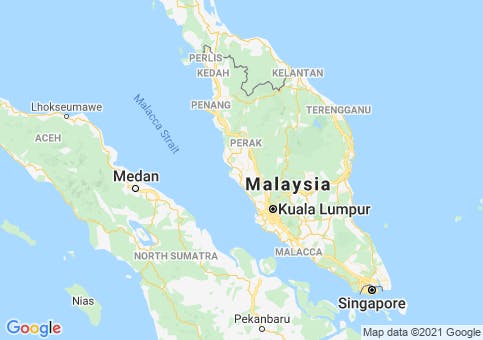There are two distinct geographical parts to Malaysia, Peninsular Malaysia (mainland) and Malaysian Borneo (East Malaysia). Peninsular Malaysia shares borders with Thailand to the north, and Singapore in the south, while the states of Sabah and Sarawak in Borneo border Indonesia Borneo to the south and the tiny sultanate of Brunei in the north. Because of the distance between them, the weather patterns in each area vary greatly.
Temperatures fluctuate across the country between 77 F and 95 F during the year, and it’s usually always hot and humid, especially in the major cities. Humidity averages 80% for much of the year so think Florida when you are considering Malaysia as an option.
East Peninsular Malaysia
Large hills separate the east and west of mainland Malaysia, bisecting the country right down the middle, and it’s this hill system that saves the west of Malaysia from turbulent weather during its monsoon season—starting in mid-October and lasting until the end of March. Rainfall at this time generally consists of heavy showers that pour for an hour or so, with the rest of the day remaining bright. Rain patterns are consistent, so if it rains on a Monday at 2 p.m., it will then rain around the same time, give or take an hour, for the next five or so days, before the pattern changes again.
This allows you to plan your outdoor activities accordingly. If you like hiking, or enjoy playing golf or tennis, knowing that it will rain in the afternoon allows you to get out early when it’s guaranteed to be dry.
West Peninsular Malaysia
The same cannot be said for East Malaysia. From May to October, there is officially a southwest monsoon, where it can rain for weeks on end. All of the resorts, and ocean-based operators on this side of the island close during this time. It’s generally a miserable place to be and consequently, very few expats live on this side of the peninsular. This is a wild, turbulent time when the east of Malaysia is to be avoided.
Sabah (Borneo)
The Malaysian state of Sabah, very much like Peninsular Malaysia, has two seasons. The wet season runs from September to January, while the dry season is from February to August. The distinction between seasons isn’t that different, and the weather patterns and rainfall levels are, in general, unpredictable. However, Sabah has regular temperatures throughout the year and only varies by about two degrees throughout the year.
There is less rain in southern Sabah than in the north, which falls evenly throughout the year between February and April.
Sarawak (Borneo)
The difference between the wet and dry seasons is more distinct in the state of Sarawak than in Sabah, with the highest rainfall in January and the lowest in June and July. Sarawak experiences roughly 250 rainy days every year, and it is, therefore, better to be prepared for rain than try and avoid it.
Temperatures remain fairly constant throughout the year though, and average between 73 F and 90 F, depending on both location and time of year.
Inland areas of Sarawak generally experience the highest levels of rain throughout the year, with a slight dip between June and August. Visitors looking to visit the indigenous tribes of this area—and there are quite a few of them—are likely to see rain, and depending on when you visit, possibly a lot of it.
Cooler Places
That being said Malaysia isn’t all heat and humidity. Cooler areas can be found in the country’s highlands. On Peninsular Malaysia the most popular cool hills for weekends away are Penang Hill, the Cameron Highlands, the Genting Highlands and Fraser’s Hill. In the state of Sarawak, Mount Kinabalu National Park and Mount Kinabalu itself are also popular.











